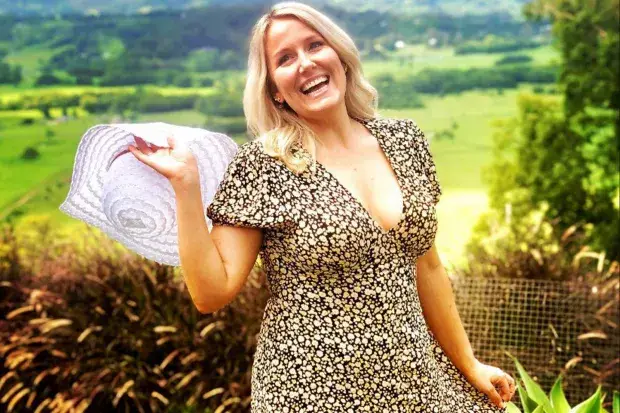In an era dominated by fast-paced reality television and curated social media personas, few public figures have demonstrated the vulnerability and resilience of Belinda Love Rygier. First introduced to audiences as a poised contestant on The Bachelor Australia in 2017, Belinda’s off-screen journey has been marked by a profound struggle with intimacy addiction—a struggle she has courageously transformed into a platform for education, advocacy, and hope. This article chronicles her evolution from a private battle with compulsive behaviors to becoming a vocal advocate for authentic connection, offering insights into the nature of intimacy addiction, the process of recovery, and the power of personal storytelling.
1. The Illusion of Reality TV Glamour
On camera, Belinda was the embodiment of confidence and poise: an ambitious marketing professional seeking genuine love amid roses and televised dates. Yet behind the scenes, she maintained a carefully compartmentalized life. While her public persona thrived under studio lights, her private world was defined by a pattern of compulsive relationships and fleeting emotional highs.
“I was living two completely different lives,” Belinda recalls. “In public, I was successful and composed. Privately, I was trapped in a cycle of seeking validation through intimacy—only to feel emptier afterward.”
Clinical psychologist Dr. Sarah Mitchell notes that this duality is characteristic of high-functioning addicts. Their accomplishments and public success can mask deep-seated turmoil, making the addiction harder to identify and address.
2. Defining Intimacy Addiction
Intimacy addiction, while not formally listed in the DSM-5, is recognized by many specialists as a behavioral disorder rooted in the compulsive pursuit of physical or emotional closeness. According to pioneering researcher Dr. Patrick Carnes, it resembles other mood-altering addictions: the individual engages in behaviors that temporarily alleviate distress, only to cycle back into craving and shame.
Key characteristics include:
- Compulsive Relationships: Rapid sequence of short-term relationships intended to fill emotional voids.
- Emotional Regulation: Reliance on romantic or sexual encounters to manage anxiety, loneliness, or low self-worth.
- Cycle of Highs and Lows: The initial intensity of new connections fades, triggering a panic-like pursuit of the next encounter.
For Belinda, the cycle escalated over years, leaving her feeling increasingly isolated despite her outward success.
3. Roots in Trauma and Attachment
Belinda’s addiction did not emerge in a vacuum. She has shared that unresolved childhood trauma and insecure attachment patterns underpinned her behaviors. Attachment theory posits that early interactions with caregivers forge templates for adult relationships. In Belinda’s case, anxious attachment manifested in frantic reassurance-seeking and identity fusion with partners.
“I became whoever I thought my partner wanted,” Belinda admits. “If they pulled away, I panicked.”
Trauma specialists emphasize that addictive behaviors often represent maladaptive attempts at healing old emotional wounds. By continually reenacting familiar patterns, individuals unconsciously hope for different outcomes—only to perpetuate pain.
4. Hitting the Turning Point
For Belinda, change did not arrive through a single dramatic episode but through a growing recognition of her own unhappiness. The ephemeral highs of new relationships shortened; the subsequent lows deepened.
“I looked in the mirror and didn’t recognize myself,” she recalls. “I realized I defined my worth through others’ eyes.”
This existential crisis prompted a courageous decision: to seek professional help and confront the addiction at its root.
5. The Path to Recovery
Recovery for intimacy addiction often parallels programs for substance use disorders, combining community support with therapeutic interventions. Belinda engaged with a structured program—likely a twelve-step fellowship such as Sex and Love Addicts Anonymous (SLAA)—and complementary psychotherapy. Her recovery framework included:
- Abstinence Period: Fifteen months of dating sobriety, allowing her to disrupt compulsive patterns and rebuild self-trust.
- Trigger Identification: Learning to recognize emotional states—loneliness, rejection, boredom—that had previously precipitated addictive behaviors.
- Healthy Coping Strategies: Embracing meditation, physical exercise, creative outlets, and platonic connections to manage distress.
- Trauma Processing: Working with a trauma-informed therapist to reframe early wounds and develop a coherent personal narrative.
- Support Network: Cultivating relationships with peers in recovery, sponsors, and mental health professionals who could offer empathy and accountability.
Belinda acknowledges recovery as nonlinear: setbacks occurred, but each moment of resistance strengthened her resolve.
6. Reframing True Intimacy
As her recovery deepened, Belinda’s conception of intimacy expanded beyond the physical realm. She now defines authentic connection as:
- Emotional Presence: The courage to share fears, hopes, and vulnerabilities without fear of abandonment.
- Mutual Acceptance: Valuing a partner for their whole person, not for their ability to fill emotional gaps.
- Holistic Bonding: Intellectual, spiritual, and creative sharing as foundations for physical closeness.
“I wanted connection—true connection,” Belinda explains. “Abstinence was not denial, but a chance to ensure intimacy was earned through genuine emotional bonds.”
Relationships expert Dr. Lisa Campbell observes that many adults conflate intensity with intimacy, resulting in quickly igniting but unsustainable connections. Belinda’s new paradigm champions gradual trust-building and consistent emotional availability.
7. From Survivor to Advocate
Today, Belinda leverages her social media presence—boasting over 30,000 followers—to demystify intimacy addiction and model healthy relational practices. Her content repertoire includes:
- Educational posts on attachment styles and emotional regulation.
- Practical strategies for setting boundaries and identifying red flags.
- Personal reflections on resilience, self-worth, and ongoing growth.
“Shame thrives in silence,” Belinda asserts. “If my story empowers even one person to seek help, my vulnerability is worthwhile.”
Mental health professionals affirm that celebrity disclosures can reduce stigma and catalyze treatment-seeking behaviors among followers.
8. Neuroscience of Healing
Modern neuroscience underscores the brain’s capacity for change—neuroplasticity—as the biological bedrock of recovery. Each time an individual chooses a healthy response over an addictive urge, they weaken old neural pathways and strengthen new ones.
Neuroscientist Dr. Amanda Chen notes:
“Consistent practice of alternative behaviors literally rewires the brain. Over time, healthier pathways become the default.”
Belinda’s daily mindfulness practices and boundary-setting exercises exemplify these rewiring processes, demonstrating that sustained recovery is both psychologically and biologically anchored.
9. Navigating Public Vulnerability
Sharing a recovery journey in the public sphere entails risks—misinterpretation, sensationalism, and boundary erosion. Belinda mitigates these challenges by:
- Maintaining discretion around third-party details.
- Focusing on universal insights rather than specific salacious anecdotes.
- Emphasizing the long-term, ongoing nature of recovery beyond headline-worthy moments.
Media psychologist Dr. Michael Levine highlights that healthy public disclosure requires intentionality: sharing to educate and connect, rather than to garner attention. Belinda’s balanced approach underscores her commitment to authenticity over spectacle.
10. Community Impact
Belinda’s advocacy has inspired direct feedback from her audience—messages from individuals who recognized their own struggles and reached out for help. These testimonials span demographics, illustrating the widespread relevance of intimacy-related issues.
“Seeing her journey gave me permission to admit my own patterns,” one follower wrote.
By normalizing conversations about behavioral addictions, Belinda contributes to a cultural shift that encourages open dialogue and early intervention.
11. Future Endeavors
Looking ahead, Belinda plans to extend her impact through:
- A forthcoming memoir detailing her recovery insights.
- Workshops and online courses on healthy relationship skills.
- Collaborations with mental health organizations to develop resources for intimacy addiction.
Her evolving mission remains rooted in transforming personal pain into collective empowerment—a testament to resilience and purpose-driven living.
12. Lessons for All
Belinda’s narrative offers universal takeaways for anyone seeking more authentic connection:
- Self-Awareness: Observe and name repeating relationship patterns without judgment.
- Seek Support: Professional guidance and peer communities accelerate healing.
- Practice Patience: Real change unfolds gradually; celebrate incremental progress.
- Cultivate Wholeness: Your worth is inherent, not contingent on external validation.
- Embrace Vulnerability: Courageous honesty fosters deeper, more meaningful bonds.
Conclusion
From her first hesitant steps on reality television to her emergence as a leading voice in intimacy addiction advocacy, Belinda Love Rygier exemplifies the transformative power of vulnerability. By confronting her own compulsions, retracing the roots of her pain, and consistently choosing healthier paths, she has reshaped her story from one of emptiness to one of authentic connection. Her journey illuminates the profound truth that healing begins not with perfection, but with the courage to share our most human struggles—and to lift others as we rise.

Adrian Hawthorne is a celebrated author and dedicated archivist who finds inspiration in the hidden stories of the past. Educated at Oxford, he now works at the National Archives, where preserving history fuels his evocative writing. Balancing archival precision with creative storytelling, Adrian founded the Hawthorne Institute of Literary Arts to mentor emerging writers and honor the timeless art of narrative.
